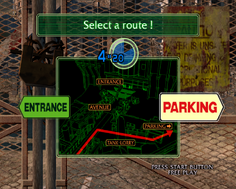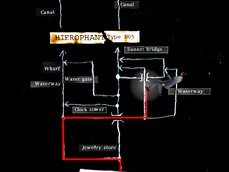(Removing some unnecessary words from the opening paragraph.) Tag: Visual edit |
m (→Development) Tag: Visual edit |
||
| (38 intermediate revisions by 5 users not shown) | |||
| Line 1: | Line 1: | ||
| + | {{article type|universe}} |
||
| − | [[File:HODIIIRouteSelect.png|thumb| |
+ | [[File:HODIIIRouteSelect.png|thumb|236x236px|A path selection option in ''[[The House of the Dead III]]''. Players can enter the [[EFI Research Facility]] either through the front entrance or the parking garage.]] |
| − | '''Branching paths '''are a gameplay mechanic in the main ''[[The House of the Dead (franchise)|House of the Dead]]'' |
+ | '''Branching paths '''are a gameplay mechanic in the main ''[[The House of the Dead (franchise)|House of the Dead]]'' series and its spiritual successor, ''[[Vampire Night]]''. The mechanic involves nonlinear level designs that are affected by player actions. |
== Description == |
== Description == |
||
| + | As the player(s) defeat enemies in rail shooter games, the camera traverses a predefined path. The main ''House of the Dead'' series and ''Vampire Night'', however, have moments where player decisions can alter the route. |
||
| + | Events that influence paths have included: |
||
| − | The main ''House of the Dead'' series and ''Vampire Night'' have a mostly nonlinear level design, with the player's decisions altering the paths taken throughout the game. |
||
| − | |||
| − | Elements that change paths include: |
||
* A [[Civilians|civilian]]'s survival or death. |
* A [[Civilians|civilian]]'s survival or death. |
||
| − | * The destruction of objects in the environment (trapdoors, locks, statues, control panels, |
+ | * The destruction of objects in the environment (trapdoors, locks, statues, control panels, etc.). |
| − | * Manipulating elevator switches by shooting them ([[The House of the Dead | |
+ | * Manipulating elevator switches by shooting them (''[[The House of the Dead (1996 video game)|The House of the Dead]]'' only). |
| + | * Taking damage from a particular enemy (''The House of the Dead ''only). |
||
* Shooting a shining object, like a key (''[[The House of the Dead 2]]'' only). |
* Shooting a shining object, like a key (''[[The House of the Dead 2]]'' only). |
||
| + | * Amount of time taken to clear a section of enemies (''[[Vampire Night]]'' only). |
||
| − | * Failing certain "controller shake" sequences in ''[[The House of the Dead 4]].'' |
||
| − | * |
+ | * Failing certain "controller shake" sequences in ''[[The House of the Dead 4]]''. |
| + | * The player's number of [[lives]] (''[[House of the Dead: Scarlet Dawn]]'' only) |
||
| − | Paths can vary in |
+ | Paths can vary in set pieces, difficulty, score potential, [[enemies]] that appear, and even where [[bosses]] can be fought. However, they all lead to the same point in the game's story. |
| − | == Route maps == |
+ | === Route maps === |
| − | [[File:JamesRouteMapHOD2.png|thumb|229x229px|[[AMS]] special agent [[James Taylor]] traversing ''[[The House of the Dead 2]]''<nowiki/>'s route map. |
+ | [[File:JamesRouteMapHOD2.png|thumb|229x229px|[[AMS]] special agent [[James Taylor]] traversing ''[[The House of the Dead 2]]''<nowiki/>'s route map.]] |
| − | Upon game over (or game completion, in the case of ''House of the Dead: Scarlet Dawn''), a map of all branching paths is shown. The routes taken are highlighted, with the player characters traversing the map; upon reaching the spot where the game ended, they fall over and die. |
||
| − | + | Upon game over (and game completion, in the case of ''House of the Dead: Scarlet Dawn''), a map of all branching paths is shown. The routes taken are highlighted, with the player characters traversing the map; upon reaching the spot where the game ended, they fall over and die. |
|
| + | |||
| + | The exceptions to this are ''Vampire Night'' and ''The House of the Dead III'', the latter of which uses circular icons to mark the player's position; they shed their color when they reach the spot where the player died. |
||
| + | |||
| + | == Development == |
||
| + | ''The House of the Dead ''developer Sega AM1 wanted the branching paths to add replay value and encourage players to discover their preferred routes. The mechanic was originally more complex and influential on the story, with the player able to choose routes when the game began. Ultimately, the mechanic was simplified due to time constraints and the Sega Model 2 arcade hardware's limited data space. Rough maps were designed to plan out the routes.<ref name=":0">"[https://archive.org/stream/Official_Sega_Saturn_Magazine_023/Official_Sega_Saturn_Magazine_023_-_september_1997_UK#page/n58/mode/2up Interview: The House of the Dead]", ''Sega Saturn Magazine'', issue 23, September 1997, page 62.</ref><nowiki/> |
||
| + | |||
| + | == Trivia == |
||
| + | * On the top left-hand corner of ''The House of the Dead 2''<nowiki/>'s route map texture, there is a hidden message: a red fingerprint accompanied by the text "Dream?" |
||
| + | * ''The House of the Dead 4''<nowiki/>'s route map has several misspellings ("''Constraction ''elevator", "Station ''attended ''room", etc). |
||
== Gallery == |
== Gallery == |
||
| + | <gallery> |
||
| − | The following are all route maps from the aforementioned games that have been currently obtained:<gallery> |
||
GameoverMap HotD1.png|''The House of the Dead'' |
GameoverMap HotD1.png|''The House of the Dead'' |
||
GameoverMap HotD2.png|''The House of the Dead 2'' |
GameoverMap HotD2.png|''The House of the Dead 2'' |
||
| − | + | GameoverMap HotD3 second.png|''The House of the Dead III'' |
|
GameoverMap HotD4.jpg |''The House of the Dead 4'' |
GameoverMap HotD4.jpg |''The House of the Dead 4'' |
||
| − | GameoverMap HotD4SP.jpg|''The House of the Dead 4 |
+ | GameoverMap HotD4SP.jpg|''The House of the Dead 4 Special'' |
The House of the Dead Scarlet Dawn – Paths Map.png|Unofficial mock-up for ''House of the Dead: Scarlet Dawn''. |
The House of the Dead Scarlet Dawn – Paths Map.png|Unofficial mock-up for ''House of the Dead: Scarlet Dawn''. |
||
| + | VampireNightPathMapScan.jpeg|''Vampire Night'' |
||
</gallery> |
</gallery> |
||
| + | |||
| + | == References == |
||
| + | <references /> |
||
[[Category:Gameplay mechanics]] |
[[Category:Gameplay mechanics]] |
||
Revision as of 19:23, 3 September 2020
(Main series and Spin-offs)

A path selection option in The House of the Dead III. Players can enter the EFI Research Facility either through the front entrance or the parking garage.
Branching paths are a gameplay mechanic in the main House of the Dead series and its spiritual successor, Vampire Night. The mechanic involves nonlinear level designs that are affected by player actions.
Description
As the player(s) defeat enemies in rail shooter games, the camera traverses a predefined path. The main House of the Dead series and Vampire Night, however, have moments where player decisions can alter the route.
Events that influence paths have included:
- A civilian's survival or death.
- The destruction of objects in the environment (trapdoors, locks, statues, control panels, etc.).
- Manipulating elevator switches by shooting them (The House of the Dead only).
- Taking damage from a particular enemy (The House of the Dead only).
- Shooting a shining object, like a key (The House of the Dead 2 only).
- Amount of time taken to clear a section of enemies (Vampire Night only).
- Failing certain "controller shake" sequences in The House of the Dead 4.
- The player's number of lives (House of the Dead: Scarlet Dawn only)
Paths can vary in set pieces, difficulty, score potential, enemies that appear, and even where bosses can be fought. However, they all lead to the same point in the game's story.
Route maps

AMS special agent James Taylor traversing The House of the Dead 2's route map.
Upon game over (and game completion, in the case of House of the Dead: Scarlet Dawn), a map of all branching paths is shown. The routes taken are highlighted, with the player characters traversing the map; upon reaching the spot where the game ended, they fall over and die.
The exceptions to this are Vampire Night and The House of the Dead III, the latter of which uses circular icons to mark the player's position; they shed their color when they reach the spot where the player died.
Development
The House of the Dead developer Sega AM1 wanted the branching paths to add replay value and encourage players to discover their preferred routes. The mechanic was originally more complex and influential on the story, with the player able to choose routes when the game began. Ultimately, the mechanic was simplified due to time constraints and the Sega Model 2 arcade hardware's limited data space. Rough maps were designed to plan out the routes.[1]
Trivia
- On the top left-hand corner of The House of the Dead 2's route map texture, there is a hidden message: a red fingerprint accompanied by the text "Dream?"
- The House of the Dead 4's route map has several misspellings ("Constraction elevator", "Station attended room", etc).
Gallery
References
- ↑ "Interview: The House of the Dead", Sega Saturn Magazine, issue 23, September 1997, page 62.







